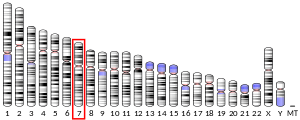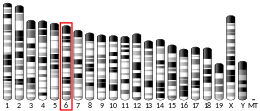TAS2R38
Taste receptor 2 member 38 is a protein that in humans is encoded by the TAS2R38 gene. TAS2R38 is a bitter taste receptor; varying genotypes of TAS2R38 influence the ability to taste both 6-n-propylthiouracil (PROP)[5] and phenylthiocarbamide (PTC).[6][7] Though it has often been proposed that varying taste receptor genotypes could influence tasting ability, TAS2R38 is one of the only taste receptors shown to have this function.[8]
| TAS2R38 | |||||||||||||||||||||||||
|---|---|---|---|---|---|---|---|---|---|---|---|---|---|---|---|---|---|---|---|---|---|---|---|---|---|
| Identifiers | |||||||||||||||||||||||||
| Aliases | TAS2R38, PTC, T2R38, T2R61, taste 2 receptor member 38, THIOT | ||||||||||||||||||||||||
| External IDs | OMIM: 607751 MGI: 2681306 HomoloGene: 47976 GeneCards: TAS2R38 | ||||||||||||||||||||||||
| |||||||||||||||||||||||||
| |||||||||||||||||||||||||
| Orthologs | |||||||||||||||||||||||||
| Species | Human | Mouse | |||||||||||||||||||||||
| Entrez | |||||||||||||||||||||||||
| Ensembl | |||||||||||||||||||||||||
| UniProt | |||||||||||||||||||||||||
| RefSeq (mRNA) | |||||||||||||||||||||||||
| RefSeq (protein) | |||||||||||||||||||||||||
| Location (UCSC) | Chr 7: 141.97 – 141.97 Mb | Chr 6: 40.61 – 40.61 Mb | |||||||||||||||||||||||
| PubMed search | [3] | [4] | |||||||||||||||||||||||
| Wikidata | |||||||||||||||||||||||||
| |||||||||||||||||||||||||
Signal transduction
As with all TAS2R proteins, TAS2R38 utilizes the G-protein gustducin as its primary method of signal transduction. Both the α- and βγ-subunits are crucial to the transmission of the taste signal.[9] See: taste receptor.
PTC sensitivity
Differential ability to taste the bitter compound phenylthiocarbamide (PTC) was discovered more than 80 years ago.[10] Since then, PTC tasting ability has been mapped to chromosome 7q[11] and, several years later, was shown to be directly related to TAS2R38 genotype.[6][7][10][11][12] There are three common polymorphisms in the TAS2R38 gene—A49P, V262A, and I296V[13]—which combine to form two common haplotypes and several other very rare haplotypes. The two common haplotypes are AVI (often called “nontaster”) and PAV (often called “taster”). Varying combinations of these haplotypes will yield homozygotes—PAV/PAV and AVI/AVI—and heterozygotes—PAV/AVI.[12] These genotypes can account for up to 85% of the variation in PTC tasting ability: people possessing two copies of the PAV polymorphism report PTC to be more bitter than TAS2R38 heterozygotes, and people possessing two copies of the AVI/AVI polymorphism often report PTC as being essentially tasteless. These polymorphisms are hypothesized to affect taste by altering G-protein-binding domains.[6]
Because bitter substances are usually toxic, the presence of a “nontaster” geno- and phenotype seems evolutionarily undesirable. Several studies have suggested, however, that the AVI polymorphism may code for an entirely new receptor which processes a different and as-yet undiscovered bitter compound.[7][10] Furthermore, the presence of the nontaster allele may reflect the desirability of maintaining a mostly heterozygous population; this group of people may possess flexibility in their bitter taste perception, enabling them to avoid a greater number of toxins than either homozygotic group.[10] Other studies, however, suggest that the AVI nontaster genotype has no functional ligand.[14] For an evolutionary perspective, the reference sequences for gorillas and chimps have the PAV haplotype, while mouse and rat have PAI.[15]
This genotypical alteration of taste phenotype is currently unique to TAS2R38. Though genotype has been proposed as a mechanism for determining individual taste preferences, TAS2R38 is so far the first and only taste receptor to display this property.[8]
PROP sensitivity, supertasting, and alcoholism
The TAS2R38 protein also confers sensitivity to the bitter compound 6-n-propylthiouracil (PROP). Because perception of PROP bitterness has been associated with supertasting, and because TAS2R38 genotypes associate with PROP-tasting phenotypes, it has been proposed that TAS2R38 genotypes may have a role in supertasting capabilities. It appears that while TAS2R38 genotypes determine a threshold of PROP tasting abilities, the genotypes cannot account for the differences in tasting amongst each threshold group. For example, some PAV/PAV homozygotes perceive PROP to be more bitter than others, and TAS2R38 genotype cannot account for these differences. Furthermore, some heterozygotes may become PROP supertasters (despite a lack of two PAV alleles), indicating overlap between PROP bitterness levels and varying TAS2R38 genotypes. These results illustrate that a mechanism beyond TAS2R38 genotype contributes to supertasting capabilities.[14]
Because fungiform papillae (FP) number varies with PROP bitterness, TAS2R38 genotype was also suspected to alter FP number. Again, however, TAS2R38 genotype could not explain FP alterations. Additionally, FP number was not a strong predictor of PROP bitterness amongst TAS2R38 heterozygotes, indicating, again, a lack of knowledge about the relationship between PROP bitterness, TAS2R38, and supertasting. Research is leaning toward a second receptor with PROP sensitivity that confers supertasting abilities.[14]
PROP bitterness and TAS2R38 genotype have been further examined in relation to alcohol intake. Research has suggested that the level of alcohol consumption may correlate with the level of perceived bitterness of ethanol; those people who find PROP to be more bitter also find the taste of ethanol to be less pleasant. Again, however, correlates between TAS2R38 genotype and the taste of alcohol were not significant: the TAS2R38 genotype could not predict the intensity of alcohol bitterness (though PROP bitterness did correlate with alcohol bitterness). Genotype could predict alcohol intake; those with nontaster alleles were more likely to consume more alcohol over the course of the year. Again, a second genetic factor seems to contribute to these phenomena. A gene altering the density of fungiform papillae may provide this second factor.[5]
See also
References
- GRCh38: Ensembl release 89: ENSG00000257138 - Ensembl, May 2017
- GRCm38: Ensembl release 89: ENSMUSG00000058250 - Ensembl, May 2017
- "Human PubMed Reference:". National Center for Biotechnology Information, U.S. National Library of Medicine.
- "Mouse PubMed Reference:". National Center for Biotechnology Information, U.S. National Library of Medicine.
- Duffy VB, Davidson AC, Kidd JR, Kidd KK, Speed WC, Pakstis AJ, Reed DR, Snyder DJ, Bartoshuk LM (November 2004). "Bitter receptor gene (TAS2R38), 6-n-propylthiouracil (PROP) bitterness and alcohol intake". Alcoholism, Clinical and Experimental Research. 28 (11): 1629–37. doi:10.1097/01.ALC.0000145789.55183.D4. PMC 1397913. PMID 15547448.
- Prodi DA, Drayna D, Forabosco P, Palmas MA, Maestrale GB, Piras D, Pirastu M, Angius A (October 2004). "Bitter taste study in a sardinian genetic isolate supports the association of phenylthiocarbamide sensitivity to the TAS2R38 bitter receptor gene". Chemical Senses. 29 (8): 697–702. doi:10.1093/chemse/bjh074. PMID 15466815.
- Kim UK, Drayna D (April 2005). "Genetics of individual differences in bitter taste perception: lessons from the PTC gene". Clinical Genetics. 67 (4): 275–80. doi:10.1111/j.1399-0004.2004.00361.x. PMID 15733260.
- Bachmanov AA, Beauchamp GK (2007). "Taste receptor genes". Annual Review of Nutrition. 27: 389–414. doi:10.1146/annurev.nutr.26.061505.111329. PMC 2721271. PMID 17444812.
- Margolskee RF (January 2002). "Molecular mechanisms of bitter and sweet taste transduction". The Journal of Biological Chemistry. 277 (1): 1–4. doi:10.1074/jbc.R100054200. PMID 11696554.
- Wooding S, Kim UK, Bamshad MJ, Larsen J, Jorde LB, Drayna D (April 2004). "Natural selection and molecular evolution in PTC, a bitter-taste receptor gene". American Journal of Human Genetics. 74 (4): 637–46. doi:10.1086/383092. PMC 1181941. PMID 14997422.
- Drayna D, Coon H, Kim UK, Elsner T, Cromer K, Otterud B, Baird L, Peiffer AP, Leppert M (May 2003). "Genetic analysis of a complex trait in the Utah Genetic Reference Project: a major locus for PTC taste ability on chromosome 7q and a secondary locus on chromosome 16p". Human Genetics. 112 (5–6): 567–72. doi:10.1007/s00439-003-0911-y. PMID 12624758.
- Kim UK, Jorgenson E, Coon H, Leppert M, Risch N, Drayna D (February 2003). "Positional cloning of the human quantitative trait locus underlying taste sensitivity to phenylthiocarbamide". Science. 299 (5610): 1221–5. Bibcode:2003Sci...299.1221K. doi:10.1126/science.1080190. PMID 12595690.
- dnSNP: rs713598, rs1726866, rs10246939
- Hayes JE, Bartoshuk LM, Kidd JR, Duffy VB (March 2008). "Supertasting and PROP bitterness depends on more than the TAS2R38 gene". Chemical Senses. 33 (3): 255–65. doi:10.1093/chemse/bjm084. PMID 18209019.
- VAR_017860VAR_017861VAR_017862
Further reading
- Montmayeur JP, Matsunami H (August 2002). "Receptors for bitter and sweet taste". Current Opinion in Neurobiology. 12 (4): 366–71. doi:10.1016/S0959-4388(02)00345-8. PMID 12139982.
- Anne-Spence M, Falk CT, Neiswanger K, Field LL, Marazita ML, Allen FH, Siervogel RM, Roche AF, Crandall BF, Sparkes RS (1984). "Estimating the recombination frequency for the PTC-Kell linkage". Human Genetics. 67 (2): 183–6. doi:10.1007/BF00272997. PMID 6745938.
- Bufe B, Hofmann T, Krautwurst D, Raguse JD, Meyerhof W (November 2002). "The human TAS2R16 receptor mediates bitter taste in response to beta-glucopyranosides". Nature Genetics. 32 (3): 397–401. doi:10.1038/ng1014. PMID 12379855.
- Zhang Y, Hoon MA, Chandrashekar J, Mueller KL, Cook B, Wu D, Zuker CS, Ryba NJ (February 2003). "Coding of sweet, bitter, and umami tastes: different receptor cells sharing similar signaling pathways". Cell. 112 (3): 293–301. doi:10.1016/S0092-8674(03)00071-0. PMID 12581520.
- Conte C, Ebeling M, Marcuz A, Nef P, Andres-Barquin PJ (2003). "Identification and characterization of human taste receptor genes belonging to the TAS2R family". Cytogenetic and Genome Research. 98 (1): 45–53. doi:10.1159/000068546. PMID 12584440.
- Pronin AN, Tang H, Connor J, Keung W (September 2004). "Identification of ligands for two human bitter T2R receptors". Chemical Senses. 29 (7): 583–93. doi:10.1093/chemse/bjh064. PMID 15337684.
- Fischer A, Gilad Y, Man O, Pääbo S (March 2005). "Evolution of bitter taste receptors in humans and apes". Molecular Biology and Evolution. 22 (3): 432–6. doi:10.1093/molbev/msi027. PMID 15496549.
- Go Y, Satta Y, Takenaka O, Takahata N (May 2005). "Lineage-specific loss of function of bitter taste receptor genes in humans and nonhuman primates". Genetics. 170 (1): 313–26. doi:10.1534/genetics.104.037523. PMC 1449719. PMID 15744053.
External links
- TAS2R38+protein,+human at the US National Library of Medicine Medical Subject Headings (MeSH)
- TAS2R38 Gene Card
- TAS2R38 OMIM Page



